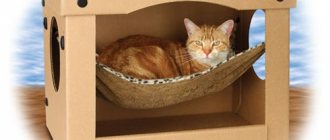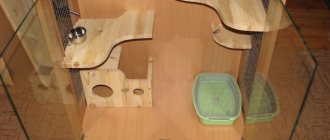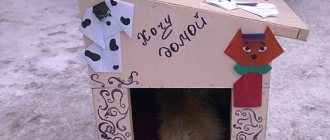The question of how to make a house for a hamster with your own hands at home is faced by the owner even before purchasing the animal. His decision depends on the size of the animal. The Dzungarians need a house less than the Syrians. This matter should not be put off until a later date, since the animal needs shelter in the first minutes of being in a new place. If time is running out, make a temporary shelter out of paper or cardboard.
What can you make a hamster house from?
The purpose of the house is to shelter the kids from prying eyes. The manufacturing material must be non-toxic, since the hamster will definitely taste it. The house will have to be cleaned; the animal should feel comfortable in it. The animal itself will show how it feels in it, having settled in a new nest.
Craftsmen make houses from cardboard and paper. Adapted for this: coconut shells, ready-made boxes, wooden planks and slats, plywood, toilet paper rollers and even popsicle sticks.
How do hamsters behave in a maze of pipes and tunnels?
To rodents, pipes resemble burrows. In nature, the homes of animals are similar to multi-path labyrinths, which is why they treat artificial tunnels favorably. This often creates problems for the owners of a new pet. If the cage has a separate “hole” in the form of a plastic tube, the animal will try to make a home for itself in it, ignoring the rest of the room. It can be worse: the animal places its toilet there. Remember, labyrinths are a very attractive part of the room for hamsters. If a new animal appears in the house, do not immediately give it a tunnel. Let him get used to you and your family and settle in a little. But there are cases when the animal still lives in the pipe, like in a house. Don't worry, leave it there, but clean the "house" regularly.
Paper house for Djungarian hamster
This temporary house will not last long. Some animals deal with it in one night. Its advantages: minimal costs and fast production. For this design you will need: toilet paper, a bowl of water and a balloon.
The procedure is as follows:
- inflate the balloon to the size of a large apple;
- Divide the toilet paper into separate sheets and moisten with water;
- stick the sheets onto the ball until about 8 layers are formed on it;
- send the structure to dry on the battery;
- pierce the ball with a needle or simply deflate;
- remove the balloon from the paper frame;
- Make an entrance for the hamster in the paper frame.
The room will resemble a hemisphere. This house is suitable for a dwarf hamster. It is short-lived and fragile.
Is it possible to keep hamsters in them?
Like any other housing for pets, terrariums and aquariums have both positive and negative sides.
pros
Glass houses have the following advantages compared to other places where hamsters are kept:
- food and bedding particles will not be scattered outside the house;
- the noise from its activity causes less inconvenience to the owners;
- You can see the animal better through the glass;
- in such a house the hamster feels much better, he is less timid;
- you can pet your pet without removing it from its home;
- Cleaning such a room is much more convenient.
Minuses
In addition to the advantages, such housing has its disadvantages:
- it must be thoroughly washed periodically;
- fresh air comes only from above;
- difficulties with securing the drinking bowl;
- to pet the animal, you need to move the lid;
- small field of activity.
Coconut shell hamster house
This design is more durable than the previous version. Despite the apparent simplicity of production, you will have to tinker with it for several hours, scraping the pulp out of the fruit. The dwelling turns out to be quite small, so it will serve as a shelter for the Djungarian hamster. Select a coconut and get to work:
You can stop there, but the home will turn out to be unstable and will roll around the cage. To avoid this, install the coconut house with the cut hole down.
On one side, draw a small arch and cut it along the contour. Sand the edges. This will be the entrance to the house. Drill holes for ventilation. If desired, you can make decorative windows on the side.
Aquarium
Many breeders have doubts about whether it is possible to keep a hamster in an aquarium. All this is due to ignorance. Worried if this will harm your hamster? Believe me, there is no reason to worry!
If you use a structure made by specialists, then rest assured that it contains everything a pet rodent needs for a full life and development. This design is made of glass (organic or regular). The top of the aquarium is covered with a metal or plastic mesh, which prevents the rodent from getting out of the home.
To ensure ventilation, the bottom of the aquarium is drilled in several places at a distance of 10 cm from the floor.
The glass bottom is covered with felt, sawdust, hay or other material that is sold in pet stores.
The dimensions of the housing should be selected based on the size of the pet. For example, aquariums measuring 100x40 cm are suitable for dwarfs. Syrian rodents will need a larger aquarium. If desired, such a design can be made with your own hands. To do this you will need glass, glass glue and a tool for cutting the material - a jigsaw.
A product made with your own hands will be no worse than a store-bought one. Plus, you will save money.
Advantages and disadvantages
The most important advantage is that in the aquarium you can provide the hamster with everything necessary for full-fledged living, development and reproduction. And it doesn’t matter what breed the pet will be.
In addition, aquariums for hamsters have other qualities:
- living in such a house, your hamster will not be able to scatter food and sawdust, which often have to be cleaned up after rodents in a cage;
- Through the glass walls it is convenient to observe the rodent’s antics from any side;
- a hamster living in such a house feels protected and completely safe;
- Through the aquariums you can pet your animal without having to remove it.
Aquariums have only one drawback - they need to be washed every time they are cleaned. There is no other way to restore order in such a house.
Wooden house for a hamster
Depending on the size, such housing can be made for both the Syrian hamster and its dwarf counterparts. The simplest design is made in the shape of a box with a removable roof, ventilation holes and an entrance for the animal. To start work, you need to prepare a sheet of plywood or a wooden board 1-4 cm thick. Plywood is more convenient. It is cheaper, easier to handle, and the hamster will not chew it so quickly. Hardwood is suitable for manufacturing.
Make markings on the prepared sheets. If the house is intended for a small hamster, the length of the front and back walls is 15 cm, with a height of 10 cm. The side walls are 10x10 cm. The lower part of the structure remains open, and for the top we put it on sheets of 17x12 cm. This is necessary so that the roof does not fall inward boxes. On the front surface it is necessary to cut out an entrance and a window, which will serve as additional ventilation. To make it easier to fasten sheets of plywood, you can nail narrow slats at the joints. To work you will need:
Each plywood part must be filed and cleaned with sandpaper. The hole for entry and ventilation is also treated with sandpaper.
First, we assemble the walls, nailing them or fastening them with screws. We place the roof on top without fixing it to the frame for ease of cleaning the room.
If it is difficult to calculate the design parameters for your animal, take a cardboard box of the required dimensions. Measure its parameters and mark the length and width you need on the plywood.
DIY pet house
It doesn’t matter what material you take to make a house, say, you want a plastic house and take an ordinary bottle, showing a little imagination. It is important to remember that safety must be maintained
An important step is to figure out what can be used to treat the top of the box so that light does not enter the house.
Hamsters love houses
Some experts advise using paint, but this is not safe, since the pet can chew it and then get poisoned. Therefore, it is best to use the second option - fabric. It can be glued directly to the house.
Then sand down any sharp corners that could cause injury to the animal. In addition, you can make homemade two-story rooms for hamsters.
coconut house
Many people are interested in how to make a house for a hamster from a coconut fruit. This is an excellent option, since the animal will not be able to chew it off and practically nothing needs to be done. Making coconut housing consists of several stages.
- The first thing you need is to buy a coconut. Choose a medium-sized coconut so that the animal can fit in it and still have room. You should also not take fruits that are already rotten.
- Then you need to drain all the liquid from the coconut. To do this, you need to make a small hole to the middle of the fruit and turn it over.
- After all the liquid has left the fruit, place it on the table and make a mark where the future entrance for the rodent will be.
- You will need to make a hole of at least 5 cm so that the animal can crawl through it; you do not need to make a hole that is too large, then the coconut will not retain heat.
- After you make a hole, you need to take out all the pulp from there. Wash the inside of the coconut thoroughly and then use stiff paper to sand down the inside.
The home is ready. You can safely put it in the cage, but it is best to secure the fruit so that it does not roll around the entire cage.
Sometimes it becomes difficult to extract the pulp. To somehow facilitate this process, it is best to make a hole and leave it in the freezer for one night. Then the next morning you will be able to see that the pulp will already be separated from the coconut.
Plywood house
A plywood house for rodents is built on almost the same principle as a birdhouse for birds. You will need plywood for this, preferably multilayer, or you can use wood about 4 cm.
Then you make two wooden bases with a total length of 13 cm, they must be cut and sanded correctly so that there are no snags and two more blanks, their length should be 15 cm each.
But you can choose the height of the house yourself so that your pet does not feel cramped and feels comfortable. It is desirable that it be at least 7 cm. Make a large hole on one of the parts, its diameter should be about 7 cm - this will be the entrance for the pet.
Also, so that air passes well and moisture does not linger, it is necessary to make several holes: 2 -3. After this, sand all the holes so that everything is good and then fasten all the parts together with nails.
The nails should not stick out inside the house; it is best for them to go outside. Nail them well so that they do not stick out at all and the animal cannot get hurt on them.
House made of tubes
This is one of the most economical and simplest ways to make a house for a rodent. You can make a home for your hamster from cardboard tubes from toilet paper rolls or paper towels.
- you need to take one tube and flatten it well;
- after that, cut out semicircles on both sides;
- straighten the tube that you folded before;
- Do exactly the same procedures with the second tube;
- insert one tube into another.
And that’s it, the labyrinth house is ready for your pet. Additionally, you can put a thyrsus in the cage; its price is low.
https://youtube.com/watch?v=JuULc5CZ7Zg
Hamster house out of a box
Using the same principle as a wooden house, you can make a house out of a box.
To do this, we will prepare a “pattern” from cardboard. We connect the walls with glue that is harmless to the animal, and cut out the entrance and windows with a stationery knife or scissors.
You can go the very simple route by using a tissue box.
Be sure to remove the plastic film from the box!
These boxes are convenient because they already have ready-made holes; they will serve as an entrance for the hamster. If you have a square box, you can simply cut it in two so that the cut line goes right down the middle of the napkin dispenser window. You will receive 2 identical houses for small animals. If the box is rectangular, you will have to make two cuts so that the future house has compact dimensions and stands stably in the cage.
Take the cardboard tube left over from the toilet paper and insert it into the opening of the box. Attach it to the edges of the hole with glue, secure it and let it dry. You have a house with a tunnel entrance.
How to set up a hamster cage?
Important criteria when choosing a building material for creating a cage in which a hamster will live are strength and safety. The size of housing is not so important for these cuties, however, large cages allow you to place all kinds of accessories for games and fun that will appeal to pets and their owners.
Cage made from plastic boxes or bottles
Capacious plastic containers, after minor modifications, become ideal for housing pets. A smaller box is suitable for a Djungarian hamster, a slightly larger one is suitable for a Syrian hamster.
The disadvantage of the design is the lack of ventilation, which can be corrected by making inserts of fine lattice in the sides and roof of the future house. The advantage of plastic: it can be freely cut with a knife or scissors, pierced with a heated awl to create holes for self-tapping screws.
Important! The sharp ends of self-tapping screws or screws should be directed outward to avoid injury to animals.
If two containers are placed one above the other, you can save on space for a second pet or equip a single animal with a second floor. In the latter case, the boxes are combined using a tunnel or ladder. Hamsters love transitions and loopholes.
The simplest tunnel can be easily made from a pair of ordinary plastic bottles, cutting them off on both sides and wrapping the sections with electrical tape. All that remains is to connect the containers together and secure them. Some owners prefer to make transitions from corrugated or sewer pipes.
For some time, a hamster can live in a house made of three six-liter plastic bottles. The upper part is cut off from them, which needs to be reduced so that a funnel with threads and a lid remains. The dishes are arranged in the form of a triangle or one on top of the other vertically. So that the animal can use all the rooms, holes are cut in the lower part of the bottles according to the size of the neck, into which blanks are inserted, playing the role of mini-tunnels.
Important! Cages made from plastic boxes or bottles can be supplemented with appropriate links and expand the living space of hamsters to reasonable limits.
Metal cage for hamster
Aquarium cage from the store
An aquarium or terrarium, as a home for a rodent, has certain advantages:
- excellent review;
- retention of odors inside the container.
Present disadvantages:
- high humidity;
- fragile design;
- difficulty in attaching accessories;
- heavy weight.
In most cases, owners cover the finished glass box with mesh. In the case of a low aquarium, it is metal; for a high capacity, the mesh material is not important. The cold bottom is lined with a thick layer of sawdust. As an option, use a plexiglass box, which is much warmer and lighter. On the other hand, it is cloudy and prone to scratches.
Interior and exterior design
Arranging a cage for an animal involves equipping it with various accessories. This includes a hammock, a running wheel, tunnels, a house, a drinking bowl, and a feeding trough.
- Wheel. Running in circles will satisfy your hamster's need for movement. The diameter is determined by the size of the animal. A twenty-centimeter design is enough for Djungarians; wheels with a diameter of 30 cm are suitable for Syrians. As they grow older, the device is replaced with another one in accordance with the growth of the animal.
Wooden cage for a hamster
Important! Choose a solid treadmill; the grid can injure your paws.
- Tunnel. Helps maintain an active lifestyle. It is also selected according to the size of the pet. The main condition: so that the hamster does not get stuck.
- Hammock. Plastic or metal rocking chairs are responsible for the development of coordination of movements.
- Drinking bowl . The animal must be provided daily with clean drinking water poured into a nipple drinker or bowl.
- Feeder. It is not necessary to acquire a special container that is difficult to turn over; food can be scattered throughout the cage. It is useful for a hamster, especially the Djungarian breed, to hone its instinct to search for food.
- Litter. As a rule, dense, odorless wood pellets or large pressed sawdust, with the exception of cedar and pine, are poured onto the bottom of the cage. Such sawdust can cause allergic reactions or bronchospasm. An alternative option is finely chopped ears of corn, which the animals love to burrow into. Mineral litters are toxic to rodents, and cat litters should not contain clay. The minimum depth of litter is 6 centimeters.
- Nesting material. To set up a nest, hamsters are allowed to offer unscented toilet paper, paper napkins or towels torn into pieces.
Toys such as toilet paper rolls or cardboard boxes will occupy the hamster's attention for a long time until he chews them. Mineral stones are used to grind teeth.
Important! When the air temperature in the room is high, it is advisable to place a piece of ceramic tile or tile with ground edges in the cage.
These objects remain cool even in the heat and the animals will be able to cool themselves by lying on them.
Very simple houses made from toilet paper tubes
It may be difficult to call this structure a dwelling in the general sense of the word, but they are suitable as shelters for animals. They are non-toxic, hidden from view and well ventilated.
For homemade tube houses, not only toilet paper is suitable, but also paper towels. Take the tube and flatten it. Using scissors, cut a semicircle on each side. Do the same operation with the second tube. Insert one tube into the hole of the other. This cross-shaped structure is suitable for dwarf hamsters.
Terrarium - a more thoughtful solution
An improved version of the aquarium is the terrarium, which is already initially equipped with a ventilation system. The dimensions of the proposed devices are different, you can choose the best option for any occasion. The design of the terrarium includes a tray and a transparent base.
The terrarium must be closed at all times, otherwise you will have to look for rodents throughout the apartment. The roof usually has a ventilation grill and a lamp that not only illuminates the space, but also heats it up, preventing the hamster from freezing.
To ensure normal air circulation, an additional grille is mounted in one of the side walls. You can independently install ventilation in the aquarium, but it will be impossible to disassemble such a structure and return it to its original appearance. The terrarium is made correctly from a technical point of view, so you do not have to independently calculate the ventilation installation parameters.
Shelter for animals made from plastic bottles
Such houses can be made for small and large hamsters. It all depends on the size of the bottle. There are many options for housing design, we will consider 2.
A simple one-bottle shelter option
To build a house, let's take a bottle that fits the width of the bottom for the animal. The lower part of the dish will be a shelter for the hamster. We cut off this part of the bottle, turn it over with the cut side down and make a semicircular entrance. Using a hot knitting needle, we pierce holes for air exchange around the perimeter of the house. We cover the cut edges of the bottle and the entrance with electrical tape so that the hamster does not get injured from the sharp edges. You can not cut out the entrance, but put a piece of the bottle on its side, and its cut will serve as the entrance. The container should be dark so that the animal feels protected.
House of two bottles
Using two bottles you can make a slightly more complex design.
Both containers are processed the same way. We cut off the bottom and neck of them. We wrap the edges first with electrical tape. In the middle of the first bottle we make a hole the same size as the second one. We do this using a stationery knife. First we make a cross-shaped cut, then bend the edges, being careful not to pull too hard. The plastic is very fragile and can crack. Insert scissors and cut a hole. Apply electrical tape to the circle. For a tighter fit, we flatten the edges of the bottle that we will insert into the hole and cut off the top and bottom edges diagonally. Wrap the edge with electrical tape. We insert the bottle into the first one. If the edges fit tightly enough, we tie the two bottles together with electrical tape.
Positive and negative aspects of buying a terrarium
Terrariums have a large number of advantages, which distinguishes structures from cages and aquariums.
Pros of terrariums:
- Excellent sound insulation;
- There are no unpleasant odors that spread throughout the apartment;
- The owner can always see what his pet is doing;
- Easy maintenance of the structure (washing, changing bedding, etc.).
The disadvantages include the difficulties associated with installing the drinker, because there are no rods to secure the product. You can immediately purchase a device with suction cups or a heavy drinking bowl that the hamster will not be able to move. Yes, and to touch the animal, you have to flip the lid up.
Features of buildings for Dzungarian and Syrian breeds
Each hamster house should be designed taking into account the size and habits of your furry pet. It is important that the active and nimble dwarfs have the opportunity to play; the rodents should be comfortable and safe in the house. Djungarian or Syrian hamsters need material to build a nest; it must be soft and environmentally friendly. It can be cotton wool, napkins, but not newspaper - the lead alloy for casting typographic fonts is dangerous for animals.
It is also necessary to take into account that small animals can escape from the house through cracks caused by poor-quality fastening of parts during manufacturing; chew a hole, finding its weak point. And larger Syrian hamsters can get stuck in a tunnel opening that is too narrow, which can be very frightening for them. Therefore, you need to take into account all the little things and constantly check your home.
Things to remember when creating a house for a rodent
The main task of a hamster's nest is to shelter the baby from prying eyes. The house should be small, but cozy, so that the animal feels comfortable and safe.
Craftsmen create houses for hamsters from various materials: coconut shell, boxes, bottles. It is important to remember that the animal tastes everything, so the material should be non-toxic and dense.
One more nuance: the house will need to be cleaned regularly. When arranging the nest, make sure that it is comfortable for you to enter it for cleaning.
Why is it necessary to equip a cage house?
Some people think that houses are just a cute extra thing for a rat's cage, but in fact they are truly essential to the well-being of your pet rodent. In the wild, rats are the prey of predatory animals, so they dig holes for safety and protection, and at home, where they cannot burrow, shelter helps them feel safe.
There are also five other reasons to buy a rat house, including:
- Stress.
Fear can be one of the stressful situations. A pet rat can be frightened by loud barking from a dog, the voices of strangers, and similar loud noises. Then the rat can crawl into the house and feel safe. If your pet does not have a place to hide, then nervous tension may cause health problems. - Cold
. If the room temperature is low, the rat may need a place to stay warm. Rats usually insulate their house with whatever materials they can find. Also, several rats sleep in one shelter, keeping each other warm. - Draft.
Rats need a house with thick walls that will not allow cold air to pass through. After all, hypothermia can cause colds or more serious illnesses. - Age.
Older rats are much less active and prefer to spend more time in shelters. They also often have health problems, so they need to feel calm and safe. - Sunlight
. Rats are sensitive to direct sunlight and hot temperatures, so the house will be an excellent shelter for them from overheating.
Advice!
Place some treats in the new hiding place. Acceptable treats: apples, carrots, broccoli, tomatoes and bananas.











